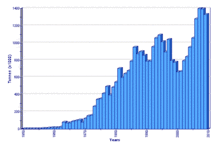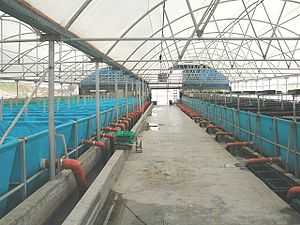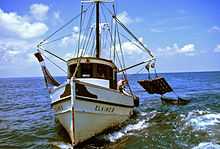Aquaculture in South Korea
General history and overview

South Korea occupies the southern portion of the Korean peninsula. The total land mass of the country is 98,480 km2 but usable land is only 20% of the total and thus the population is concentrated around the coast.[2][3] The Korean Peninsula is surrounded by the East, West and South Seas, a coast-line that extends for about 2,413 km. Endowed with an abundance of fisheries resources, Koreans have developed a distinct seafood culture with annual per capita sea food consumption of 48.1 kg in 2005.[2]
Years of capturing wild fish together with improved fishing technology have led to a continuous decrease in capture production in South Korea in recent years, and consequently led to a greater attention to aquaculture to meet the increasing demand for aquatic products.
Extensive aquaculture has been practiced in Korea for several hundred years, but modern intensive aquaculture (mainly for seaweed and shellfish) did not emerge until the 1960s.[4] However, total annual aquaculture production was less than 100,000 tonnes in this period. Aquaculture production increased from 147,000 tonnes in 1971, reaching over 1.2 million tonnes by 2006.[2]
Cultured species
Current aquaculture production in South Korea is dominated by seaweeds, followed by molluscs and finfish.[2][5]
| Fishery products | Tonnes[2] | Percentage[2] |
|---|---|---|
| Seaweed | 764 913 | 60.7 |
| Shellfish | 391 060 | 31.1 |
| Finfish | 91 123 | 15.2 |
| Others | 12 128 | 0.9 |
| Total | 1 259 274 | 100 |
Aquaculture in the sea has developed differently due to the variation of three different coastal regions.[6]
- East Coast - Because of simple coastal line and strong wave action, there are only land based cultures near the coast. Flatfish (Paralichthys olivaceus) and scallop (Patinopecten yessoensis) are the main species cultured in east coast of South Korea.
- South Coast - There are a number of semi-enclosed bays, islands and estuaries with moderate tidal ranges. Archipelagic environment makes it an ideal place for installation of cages. Aquaculture production in south coast is much higher than production in east and west coast.
- West Coast - Warm (up to 26 °C) estuarine environment with high tidal range and well developed tidal flat enables crustacean and shellfish production in this region. Trials for the use of earthen pond for finfish have been successful.

Seaweed
55% of aquaculture production in South Korea is encompassed by seaweed.[1] However, fish production is increasing rapidly.[6] Seaweed culture is mainly concentrated on the South western coast where almost 90% of cultivation of seaweed in South Korea takes place. Cultured seaweed species include sea mustard (Caulerpa sp.), laver (Porphyra spp.), kelp (Laminaria spp.), fusiform (Hizikia fusiformis), green laver (Monostroma sp.) and codium (Codium sp.).[5] The brown seaweed Undaria dominates algal aquaculture production constituting 42% of the total wet weight.[7] Laver production is however the most valuable, totaling 65% of overall value. The production is estimated to be 217,559 tonnes (wet wt.) which is equivalent to more than 10 billion sheets of dried laver.[2]
Shellfish
Molluscs are the second most important group of marine aquaculture products. The primary species produced, including the oysters (Crassostrea gigas and Pinctada fucata), Korean mussel (Mytilus coruscus ), the sea squirt red oyas (Halocynthia roretzi), the Japanese carpet shell (Ruditapes philippinarum ), ark shells (Anadara satowi and A. broughtonii), cockles (A. granosabisenensis and A. subcrenata), Yesso scallop (Patinopecten yessoensis) and abalone (Haliotis discus hannai).[5] Production of molluscs reached 391,060 tonnes in 2006, making up 31.1% of the total aquaculture production of South Korea.[2]
Oysters are considered to be the most important molluscan shellfish in the aquaculture industry of South Korea, which, in 2005, produced 251,706 tonnes of oysters.[8][9] Approximately 90% of the Korean oysters come from farms located in small bays and off islands along the southern coast.[8] Oyster farming is highly popular, as it produces high profits. For example in 2003, one oyster farming family worked on 126 oyster long-lines producing a net profit of 33,000 US Dollars.[10]
Finfish
Marine finfish culture is dominated by bastard halibut (Paralichthys olivaceus), Korean rockfish (Sebastes schlegeli), mullet, seabass, yellowtail, red seabream, black seabream, brown croaker and puffers.[5]
Finfish are the most important species in freshwater aquaculture; species in this group include trout, mud fish (Clarias sp.), Japanese eel (Anguilla japonica), tilapia, common carp, loach, colored carp, snakehead (Channa sp.), sweet fish, Korean bullhead (Pelteobagrus fulvidraco), goldfish and mountain trout.[5]
Crustacean
Crustacean culture is primarily concerned with two species of shrimp and some crabs. Fleshy prawn (Fenneropenaeus chinensis) and kuruma prawn (Marsupenaeus japonicus) are the prime species of shrimp being farmed with the former raised mostly in farms along the west of the peninsula and the latter in farms in the southern region.[5]
Trends and development
There have been deliberate efforts to shift from the production of low value aquaculture species such as seaweeds to high value species, such as oyster in South Korea. The government has been pursuing a long-term aquaculture development programme through the expansion of areas for aquaculture and the intensified development of both profitable and unexploited species. Already certain tidal areas in the southern provinces have been designated for shellfish culture. The number of aquaculture facilities will be reduced by 10% over the next five years, and new licences will not be issued for such products as laver, sea-mustard and “excessively-produced fishes”.[7][11] Another reason for the slow down in growth is the loss of some aquaculture areas to industrial pollution, such as the case with oysters.
By turning to more advanced aquaculture fisheries, the Ministry of Maritime Affairs and Fisheries (MOMAF) plans to encourage the industry to reduce production costs so that it can compete favourably with its foreign counterparts.[12] Between the period of 1997 and 2003, aquaculture production of aquatic plants dropped by 30% and mussels by 75% [14]. On the other hand demersal fish such as olive flounder and black rockfish increased by 78% [14]. There has equally been an increased interest in farming of shrimps (P. chinensis and P. japonicus) and the mitten-handed crabs, previously only cultured in China. As a result crustacean production has increased by 48% between 1997 and 2003.[11]
Future directions
There has been a great increase in production of high value fish species, such as olive flounder and black rockfish during the last few years and a new interest in culturing penaeid shrimps.[12] The vision of South Korea is a restructured aquaculture industry with an optimal production system and enhanced competitiveness. While doing this, Korea will be reducing by 10% production facilities devoted to high volume products such as laver and sea-mustard with no new licences to be issued during the next five years.[10][13] Total funds invested were US $14.9
There is a growing concern that pollution might affect fishing and aquaculture production[14] due to the reclamation works and construction of industrial complexes in the southern and western coastal districts of the country.[5]
Recently, the integrated aquaculture management has created an alternate plan to overcome problems such as red tide, typhoon and pollution created by human activities.[6] In this plan, the scope of ‘aquaculture ground’ extends to open areas. It is divided into three subdivisions; land-based aquaculture, polytrophic aquaculture, and offshore aquaculture, all of which are relatively new concepts in Korean aquaculture industry.[6][15]
References
- ↑ 1.0 1.1 FAO (2005). "Aquaculture production, 2003". Yearbook of Fishery Statistics. 2 96.
- ↑ 2.0 2.1 2.2 2.3 2.4 2.5 2.6 2.7 Yoon, G.H. (2008). "Aquaculture in Korea". Aquaculture News 34: 16–17.
- ↑ CIA (2003). The World Fact Book 2002 - Korea, South. Central Intelligence Agency.
- ↑ World Fishing and Aquaculture. "South Korea. World Fishing and Aquaculture, New Horizons". Retrieved 2011-09-22.
- ↑ 5.0 5.1 5.2 5.3 5.4 5.5 5.6 FAO. "National Aquaculture Sector Overview. Republic of Korea. National Aquaculture Sector Overview Fact Sheets". FAO Fisheries and Aquaculture Department. Retrieved 2011-09-21.
- ↑ 6.0 6.1 6.2 6.3 Lim, H.K. (2006). "Korean Aquaculture: Status and Future Directions". National Fisheries Research and Development Institute 12: 4–8.
- ↑ 7.0 7.1 OECD (2002). "Draft review of fisheries, Part 8: Korea". OECD Report No. AGR/FI 11 (8): 13.
- ↑ 8.0 8.1 Choi, K.S. (2008). "Oyster Capture-based Aquaculture in the Republic of Korea". FAO Fisheries Technical Paper 508: 271–286.
- ↑ Choi, K.S. "Current Status of Korean Shellfish Aquaculture". Retrieved 2011-09-19.
- ↑ 10.0 10.1 Choi, K.S. /Oyster-Choi.pdf "Oyster Aquaculture in Korea". Retrieved 2011-09-18.
- ↑ 11.0 11.1 Network of Aquaculture Centres in Asia-Pacific (2006). Regional review on aquaculture development. 3. Asia and the Pacific – 2005. FAO Fisheries Circular. No. 1017/3. p. 97. ISSN 0429-9329.
- ↑ 12.0 12.1 Ministry of Maritime Affairs & Fisheries (MMAF) (1999). "Long term development plan for the Korean aquaculture industry of the 21st century.".
- ↑ FAO (2000a). "Report of the KMI/APRACA/FAO Regional Workshop on the Effects of Globalization and Deregulation on Marine Capture Fisheries in Asia and the Pacific, Pusan, Republic of Korea, 11–15 October 1999". FAO Fisheries Report 624.
- ↑ FAO (2004–2011). "Fishery and Aquaculture Country profiles. Republic of Korea. Fishery and Aquaculture Country Profiles". FAO Fisheries and Aquaculture Department.
- ↑ Asianinfo. [. http://www.asianinfo.org/asianinfo/korea/fisheries.htm "Fisheries in Korea"]. Retrieved 2011-09-20.
| |||||||||||||||||||||||||||||||||||||


